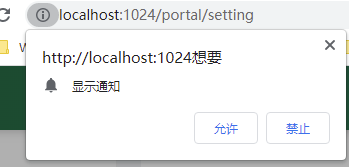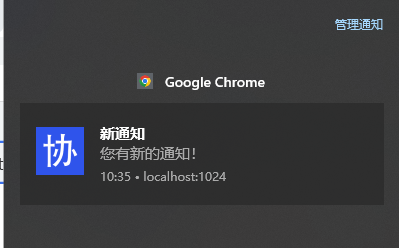chrome浏览器通知与语音播放
HTML5 Web Notification 语法 https://developer.mozilla.org/zh-CN/docs/Web/API/notification
如果浏览器支持Web Notification,不考虑私有前缀,则window.Notification就会是一个有很多静态属性和实例方法的函数。
基本上,Web Notification所有的语法都是围绕Notification这个函数来进行的。
显然,通知这种事情是有可能扰民的,因此,必须经过用户同意才行。因此:
浏览器授权当前页面允许通知
检测当前页面权限状态
只读属性 Notification.permission 该属性的值将会是下列三个之一:
default:用户还未被询问是否授权,所以通知不会被显示。
granted:表示之前已经询问过用户,并且用户已经授予了显示通知的权限。
denied:用户已经明确的拒绝了显示通知的权限。
if (window.Notification && window.Notification.permission !== 'granted') { window.Notification.requestPermission(); }
浏览器会弹出授权弹窗

配置和显示桌面通知
最新的Chrome的Notification要想有效果需要
https协议才行let notification = new Notification(title, options)
title 一定会被显示的通知标题
options 可选 一个被允许用来设置通知的对象。它包含以下属性:
- dir : 文字的方向;它的值可以是 auto(自动), ltr(从左到右), or rtl(从右到左)
- lang: 指定通知中所使用的语言。这个字符串必须在 BCP 47 language tag 文档中是有效的。
- body: 通知中额外显示的字符串
- tag: 赋予通知一个ID,以便在必要的时候对通知进行刷新、替换或移除。
- icon: 一个图片的URL,将被用于显示通知的图标。
notify( title: string = '新通知', body: string = '您有新的通知!', openurl: string ) { if (window.Notification) { const n = new Notification(title, { icon: icon, body: body, }); n.onclick = () => { window.open(openurl); }; } }

浏览器语音播放
private createAudio() { const audioElm = document.createElement('audio'); audioElm.autoplay = true; audioElm.muted = false; audioElm.src = '/assets/audio/notify.wav'; return audioElm; } /** * 播放声音 */ play() {if (!this.audioElm) { this.audioElm = this.createAudio(); document.body.appendChild(this.audioElm); } this.audioElm.play(); }
简单使用就自己写,也可以使用这个插件
https://github.com/jaywcjlove/iNotify





